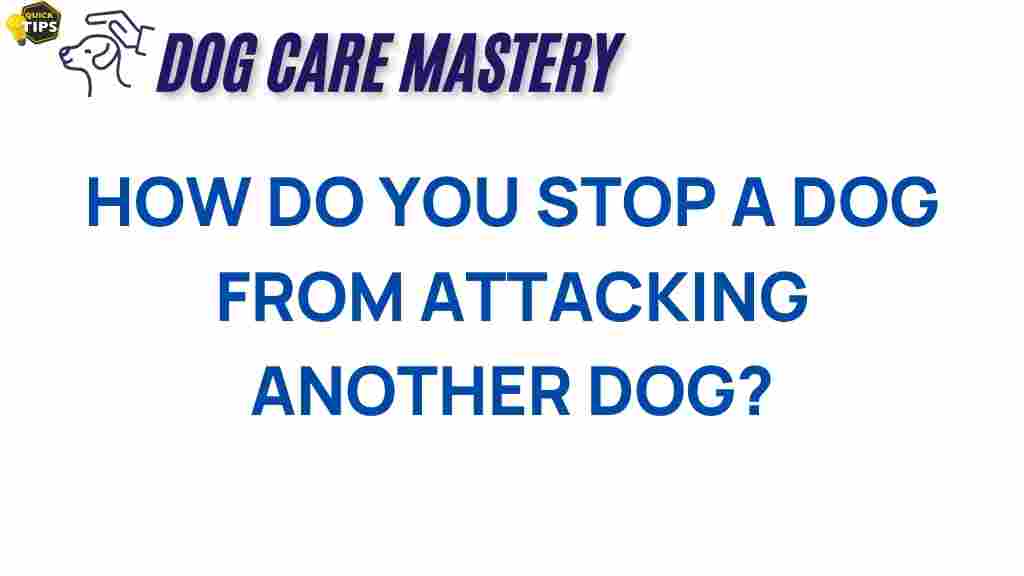Unraveling the Mystery: How to Prevent Dog-on-Dog Aggression
Dog aggression is a common concern among pet owners, especially when their furry friends interact with other dogs. Understanding the triggers and prevention strategies is essential for maintaining a harmonious environment for all dogs involved. This article will explore the causes of dog aggression, effective prevention techniques, and troubleshooting tips to help you promote positive interactions among dogs.
Understanding Dog Aggression
Before diving into prevention strategies, it’s crucial to understand what dog aggression entails. Aggression in dogs can manifest in various forms, including:
- Fear-based aggression: Often a response to perceived threats.
- Territorial aggression: Protecting their space from intruders.
- Resource guarding: Protecting food, toys, or other valued items.
- Play aggression: Rough play that can escalate into aggressive behavior.
Recognizing these types of aggression can help you intervene before a situation escalates. The next step is to focus on prevention.
Step-by-Step Process to Prevent Dog Aggression
Preventing dog-on-dog aggression requires a proactive approach. Here’s a step-by-step guide to help you navigate this complex issue:
1. Socialization is Key
Early and ongoing socialization is vital in preventing dog aggression. Expose your dog to various environments, people, and other animals to help them become well-adjusted. Consider the following tips:
- Start socialization during puppyhood, ideally before 16 weeks.
- Gradually introduce your dog to different breeds and sizes.
- Encourage positive interactions through treats and praise.
2. Identify Triggers
Understanding what triggers your dog’s aggression is crucial. Keep a journal to track incidents of aggression and identify patterns. Common triggers include:
- Unfamiliar dogs
- Specific locations, like dog parks
- High-stress situations, such as crowded areas
3. Training and Commands
Basic obedience training can significantly reduce instances of dog aggression. Commands like “sit,” “stay,” and “leave it” can redirect your dog’s focus. Consider the following training techniques:
- Positive reinforcement: Reward good behavior with treats or praise.
- Consistency: Use the same commands and cues to avoid confusion.
- Professional help: Consult a certified dog trainer for additional support.
4. Controlled Introductions
When introducing your dog to new canine friends, ensure the first encounters are controlled and monitored. Follow these guidelines:
- Choose a neutral location for the introduction.
- Use leashes to maintain control but avoid pulling.
- Allow dogs to sniff each other while maintaining a safe distance.
5. Monitor Body Language
Dogs communicate through body language. Learning to read your dog’s signals can help you prevent aggressive incidents. Watch for:
- Raised hackles or stiff posture
- Growling or barking
- Averted eyes or yawning excessively
6. Create a Safe Space
A designated safe space allows your dog to retreat when feeling overwhelmed. Make sure this area is comfortable, quiet, and filled with their favorite toys. This can help reduce anxiety and aggression.
Troubleshooting Tips for Dog Aggression
Even with preventive measures in place, some dogs may still exhibit aggressive behavior. Here are some troubleshooting tips:
1. Consult a Veterinarian
Sometimes, aggression can stem from underlying health issues. A thorough veterinary check-up can rule out pain or medical conditions that may contribute to aggressive behavior.
2. Evaluate Your Environment
Assess your living situation. High-stress environments can exacerbate dog aggression. Consider making changes such as:
- Reducing noise levels
- Establishing a routine for your dog
- Creating a calm atmosphere in the home
3. Avoid Punishment
Using punishment as a corrective measure can increase fear and anxiety, leading to more aggressive behavior. Instead, focus on positive reinforcement techniques to encourage desirable behaviors.
4. Seek Professional Help
If dog aggression persists despite your efforts, it may be time to consult with a professional dog behaviorist. They can provide tailored strategies and insights specific to your dog’s needs.
Conclusion
Preventing dog-on-dog aggression is a multifaceted process that requires patience, understanding, and consistent effort. By following the steps outlined above, you can create a safer and more enjoyable environment for your dog and others. Remember, socialization, training, and awareness of triggers are key components in addressing dog aggression. If you’re looking for more resources on dog training, check out this comprehensive guide. For further assistance, consider seeking expert advice from a professional trainer or behaviorist.
By unraveling the mystery of dog aggression and implementing preventive measures, you can foster positive interactions and ensure your dog’s well-being. Your commitment to understanding and addressing this behavior will not only benefit your dog but also contribute to the overall happiness of your community’s canine companions.
This article is in the category Behavior and created by dogcaremastery Team
